Ahwazi people drink dirty water and breathe polluted air

Ahwazna
The region is undergoing uncertain future due to air and water degradation. The government should take serious action to improve the ongoing environmental crisis. Water diversion from Karoon and other flowing rivers and building water dams must be stopped since these are contributed to bare and dry international marshes and wetlands in the region.
According to officials in Al-Ahwaz concerned with the environment issues, the particle density in Ahwaz city is 46 times above the authorized limit, and some flights had to be canceled.
Last year the same problem forced the closure of numerous Schools and offices of multiple cities of the province. Mr.Naser Sudani Ahwaz representative in the Iranian parliament stated: “Air pollution in Khuzestan province (North of Al-Ahwaz region) is 66-70 times above the authorized and it surpassed the crises phase." This parliamentary has previously asked the Iranian state president to form a group of disaster management experts to address the air pollution problem in the province.
It is worth mention that last February number of Ahwazi citizens gathered in front of Ahwaz municipality building in objection to what they called "negligence of officials toward the Air Pollution." These residents called for immediate action on both provincial and national level to address and solve this phenomenon.
It has been stated by the UNEP environmental experts that drought of the wetlands is one of the main reasons of dust storm erupted recently in the Ahwaz region. Also, the environmental organizations announced in April that more than fifty percent of the Ahwazi wetlands and lakes and rivers dried up or are endangered to drought and consequently dying of biodiversity, fish and rare species.
Recently local media published dying of millions of fishes and created thousands of local Arab fishermen jobless.
Ever since, the water level of Dez, Karoon, and Karkheh rivers has fallen by 65%, 45%, and 50% respectively. The region is facing a bleak future due to air and water pollution. In order for the ongoing crisis to end, the government has to change its policy and take prompt and widespread action. It has to stop water diversion from the Karoon River and its tributaries and remove the Gotvant embankment dam on the Karoon River, as well as other dams which have dried up the Ahwazi wetlands.
This appears to be part of a consciously planned Iranian regime policy of ethnic cleansing, forcing the people to abandon their lands which can subsequently be resettled by ethnically Persian, non-Arab Iranian citizens in order to change the demographic balance."


